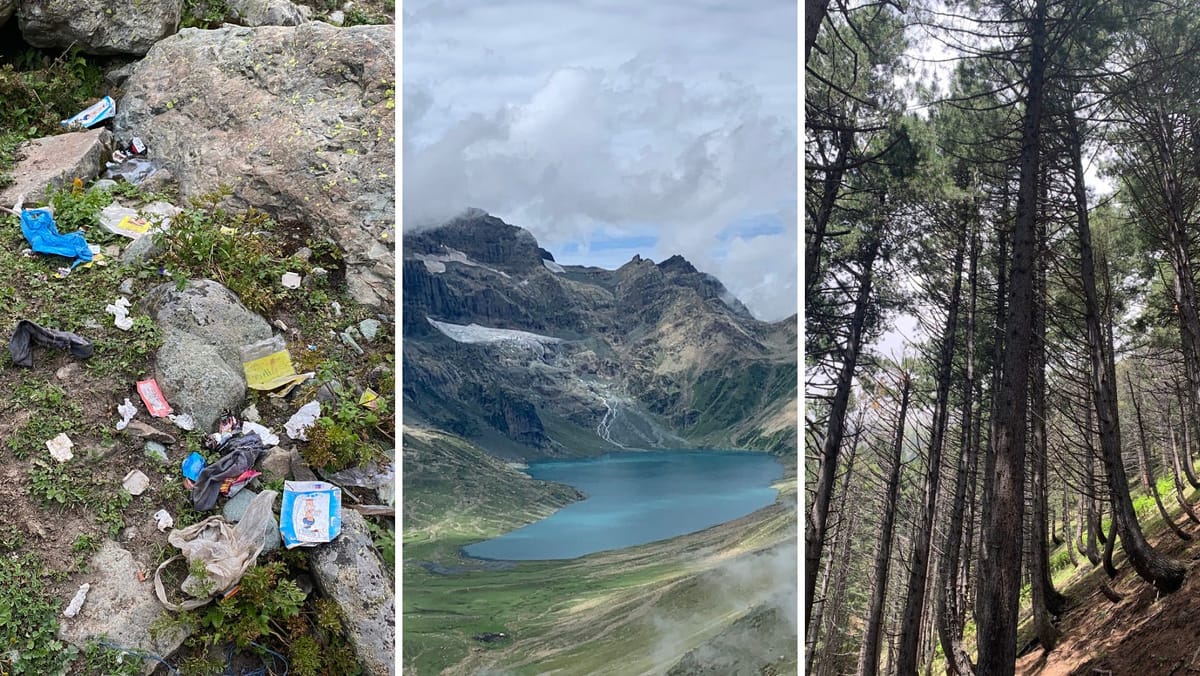We are losing the Himalayas, and it's our fault
High-altitude trekking forces you to cut off from the cluttered city life. But we’ve brought so much of our junk to the mountains, local kids ran up to us and begged, “Toffee de do”!

Which of these photos would you say were not clicked in Kashmir?
The first one?
Wrong.
I recently trekked across Kashmir — to take in the state’s raw natural beauty without the touristy gimmicks. Through the nearly 90-km trek, I phrased and rephrased in my head the words I would use in this post to describe the delicious, but underrated, vegetarian cuisine of Kashmir. The Dum Aloo, Nadru (Lotus Stem curry), Saag Paneer… this is meant to be a food/history/culture Substack after all.
As I now sit to write, I am not able to romanticise the mountains or this land’s food, after seeing hundreds of thousands of travellers trash our “Heaven on Earth”.
Kashmir has unlimited mountain passes, but a limited window for trekkers to explore them. Between the months of June and September — when Kashmir traverses from monsoon to autumn — is considered an ideal trek window.
I trekked the Kashmir Great Lakes route - from Sonmarg to Naranag through a six-day circuit that ascends three high-altitude passes, reaching a maximum of 13,700 ft above sea level, taking us to seven beautiful, turquoise lakes nestled between tall mountains, and then across gushing streams, a treacherous boulder climb and finally, a 12-km unending descend through forests.
By no means is this an easy trek, or one for beginners, as the fittest in our group admitted. But where earlier, only the serious, minimal trekker who carried her own backpack and left little trace of her impermanent and transient presence in the mountains visited, today hordes of people of all ages, with varying trek experiences, offloading heavy backpacks onto overburdened mules, have made the Kashmir passes their playground.
Do not get me wrong, everyone must do high-altitude treks at least once in life. It puts one in extremely uncomfortable situations and transforms them in more ways than can be counted.
But, change can only happen to those open to it. What we saw was just one big party high up in the mountains, a bunch of people who carried their city with them.
I have been trekking since 2015, much before it became a popular way to travel and way before Instagram dictated trip itineraries. At the time, I found trekking the most budget-friendly, quiet way to see a state, and it became addictive. For some seven years, every time I set foot in the Himalayas, I would automatically switch on mountain mode - the rose-tinted hmmm mountains feel.
This time, I felt no such thing. I tried so hard to go hmmm, and every time it failed, I grew more frustrated. Why couldn’t I let go?
Because, just as I was trying, a hundred other trekkers were also. All of us, crowding the single most Instagrammable spot of a rest point or cliff, clicking away, posing, smiling and hmmming.
Most trekkers also choose to trek as it forces them to cut off from their cluttered city lives. It’s a detox from phones, junk food, snacking and sedentarism. We don’t reach out to chocolates or protein bars for energy, but to local produce —such as apples or dates in Kashmir.
Not anymore.
Our trek trail was littered with chocolate wrappers, chips packets, protein bar covers, chewed gum and other such waste that can severely imbalance what is already a fragile ecosystem. And we’ve brought so much of our junk here, local kids would run up to us and beg, “Toffee de do”!
I was fortunate to have travelled with an organisation that has pledged to leave the mountains better, and we collected whatever trash we could along the way. But you would need truckloads of a good footprint to offset all of this bad footprint.
What really put me off was the traffic jam on the narrow trails, where trekkers and mules competed for space.
By virtue of being Kashmir, permissions to trek and camp come with severe restrictions. No group is allowed to set up even semi-permanent campsites. This means, every morning, groups pack up entire campsites - tents, kitchens, toilets, utensils, gas cylinders - and move on to the next campsite. This might have been sustainable if trekker numbers were under 100 a week. What we saw was a pure mess.
In the one week that we were there, there were at least 1,000 trekkers who had started at the same time as us, trekking the same route. All of our tents, kitchens, utensils and toilets moved with us, every single day. Add to this load those trekkers — many young, fit, strong ones — who offloaded their backpacks.
Thousands of mules carrying all of this luggage, and their guides, slowly trudged up and down the mountains with us. We saw at least two dead mules on the route, and one that was so overburdened, that it lost balance, fell on a woman trekking next to it and somersaulted some 10 feet down the mountain. The mule survived, the woman injured her spine and was transported to the nearest army camp on a stretcher. We do not know how she is.
We cannot entirely blame the trekkers when the sector is so unregulated and there is little regard for preserving our natural heritage. It’s a classic chicken-egg scenario. And while I could propose solutions like limiting trekker numbers or stricter rules for organisers, little might change unless we the trekkers decide to protect our mountains.
No form of travel is sustainable for the planet. Trekking used to be relatively more sustainable than other forms. But what I saw shocked me. Not only was this trek completely unsustainable, but it also stole from what a trek could teach you — the values of hard work, minimalism, respect for nature and humility.